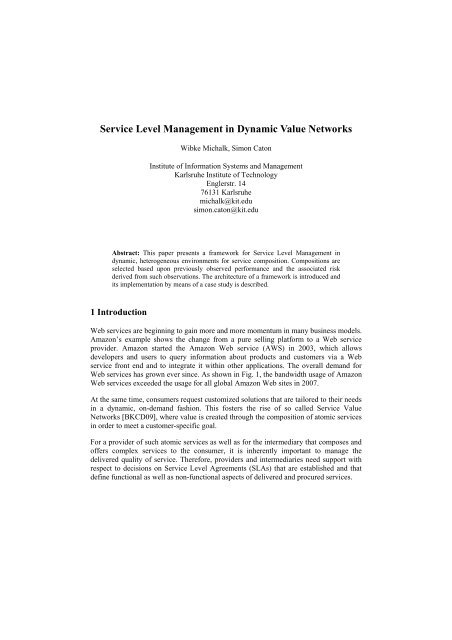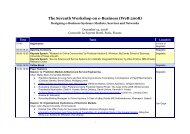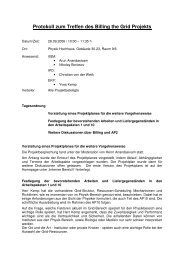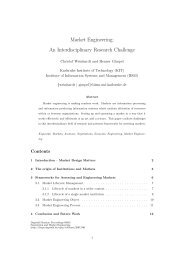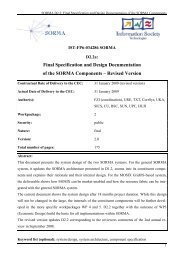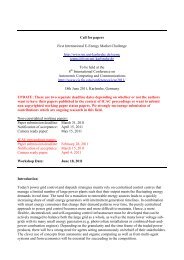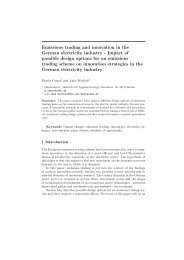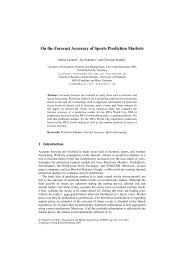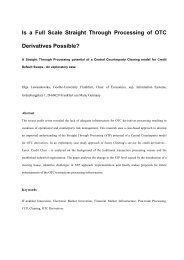download - KSRI - Karlsruhe Service Research Institute - KIT
download - KSRI - Karlsruhe Service Research Institute - KIT
download - KSRI - Karlsruhe Service Research Institute - KIT
You also want an ePaper? Increase the reach of your titles
YUMPU automatically turns print PDFs into web optimized ePapers that Google loves.
<strong>Service</strong> Level Management in Dynamic Value Networks<br />
Wibke Michalk, Simon Caton<br />
<strong>Institute</strong> of Information Systems and Management<br />
<strong>Karlsruhe</strong> <strong>Institute</strong> of Technology<br />
Englerstr. 14<br />
76131 <strong>Karlsruhe</strong><br />
michalk@kit.edu<br />
simon.caton@kit.edu<br />
Abstract: This paper presents a framework for <strong>Service</strong> Level Management in<br />
dynamic, heterogeneous environments for service composition. Compositions are<br />
selected based upon previously observed performance and the associated risk<br />
derived from such observations. The architecture of a framework is introduced and<br />
its implementation by means of a case study is described.<br />
1 Introduction<br />
Web services are beginning to gain more and more momentum in many business models.<br />
Amazon’s example shows the change from a pure selling platform to a Web service<br />
provider. Amazon started the Amazon Web service (AWS) in 2003, which allows<br />
developers and users to query information about products and customers via a Web<br />
service front end and to integrate it within other applications. The overall demand for<br />
Web services has grown ever since. As shown in Fig. 1, the bandwidth usage of Amazon<br />
Web services exceeded the usage for all global Amazon Web sites in 2007.<br />
At the same time, consumers request customized solutions that are tailored to their needs<br />
in a dynamic, on-demand fashion. This fosters the rise of so called <strong>Service</strong> Value<br />
Networks [BKCD09], where value is created through the composition of atomic services<br />
in order to meet a customer-specific goal.<br />
For a provider of such atomic services as well as for the intermediary that composes and<br />
offers complex services to the consumer, it is inherently important to manage the<br />
delivered quality of service. Therefore, providers and intermediaries need support with<br />
respect to decisions on <strong>Service</strong> Level Agreements (SLAs) that are established and that<br />
define functional as well as non-functional aspects of delivered and procured services.
The decisions of providers and intermediaries have to reflect quality attributes of the<br />
services, prices and penalties. However, besides, the reliability of the procured service,<br />
the risk of potential penalties has to also be taken into account. This decision is<br />
exemplified in the project ValueGrids 1 and will be illustrated in this work.<br />
The remainder of this work is structured as follows. Section 2 gives a brief overview<br />
over Related Work. The ValueGrids Framework and especially the decision support<br />
component are presented in Section 3, whereas Section 4 illustrates the use case. Section<br />
5 concludes the paper and gives an outlook to future work.<br />
Fig. 1: Demand for Web services 2<br />
2 Related Work<br />
The technical composition of Web services that facilitates the provision of automated<br />
complex services such as insurance brokering, travel planning, insurance liability<br />
services or package tracking has been discussed intensively in the literature. In order to<br />
facilitate the provision of complex services via platforms such as Salesforce, services<br />
need to be combinable. One approach of standardization is described in the serviceoriented<br />
architecture (SOA), where the composition of complex applications from<br />
loosely-coupled service components that provide specific well-defined functionality is<br />
the main goal. Here, service components are reusable and composable in different<br />
application areas [Ley03]. The composability of Web services is ensured through the<br />
application of specifications. Web services may be described using standards as WSDL<br />
[CCMW01] that specifies the interface and hence, how to communicate with the service<br />
by means of an XML-schema definition. WSDL is regarded as a basis for the work at<br />
hand but has to be extended by a term language in order to be able to describe <strong>Service</strong><br />
Level Objectives (SLOs), that is, the quality goals that are agreed in the SLA and prices<br />
and penalties.<br />
1 www.valuegrids.de<br />
2 http://aws.typepad.com/aws/2008/05/lots-of-bits.html – last accessed May 2010
While [PD04] introduce a definition for a complex service as well as different<br />
technologies for Web service composition, [BMNW08] focus on a semantic way to<br />
combine Web services by introducing a Generic <strong>Service</strong> Ontology. The aforementioned<br />
literature does mainly allow for the technical composition and the feasibility of<br />
combining services, whereas the approach at hand seeks to answer the question for riskminimal<br />
agreement conclusion.<br />
The joint provision of complex services only becomes feasible through the establishment<br />
of service level agreements (SLAs) among service providers. <strong>Service</strong> Level Agreements<br />
govern the provision of services by means of specifying the involved parties and the<br />
service to be executed. The service description in an SLA covers functional aspects as<br />
well as non-functional aspects that define the quality of service. A formalization of<br />
service level agreements (SLAs) is proposed in [ACD+07].<br />
Whereas the establishment of SLAs builds the basis for service monitoring, the risk of<br />
failure that results from adherence to past contracts will be considered in the work at<br />
hand. The chosen approach for risk calculation is based on security portfolio<br />
optimization as introduced by Markowitz [Mar52] and only takes downside risk into<br />
account [Mar91]. The following sections will illustrate risk-aware decisions in dynamic<br />
and heterogeneous environments like <strong>Service</strong> Value Networks by means of a case study.<br />
3 <strong>Service</strong> Level Management<br />
Fig. 2: ValueGrids Framework
ValueGrids establishes and delivers an integrated concept for service level management<br />
in service value networks. For participants like service providers and intermediaries,<br />
service level management mainly comprises of the choice of contract partners and<br />
respective agreements to be established. Decisions concerning the establishment of<br />
contracts will be driven by the risk of violating one or several contracts. Under the<br />
assumption that service providers and intermediaries do not want to violate an SLA<br />
under any circumstance in order to avoid the payment of penalties, the decisions<br />
supported by the Dependency Analyzer are based on past observations of SLA<br />
adherence.<br />
<strong>Service</strong> providers and intermediaries use the ValueGrids Management Cockpit to come<br />
to a decision (cf. Fig. 2). Here, SLA requests are made and information is handed over to<br />
the Dependency Analyzer (DA). The DA retrieves all possible service compositions<br />
(topologies) for the required service from the <strong>Service</strong>/SLA Repository (cf. Fig. 3) and<br />
uses this information to calculate the risk associated with each of the service topologies.<br />
Fig. 3 illustrates that based on the retrieved topologies, the monitoring reports are<br />
queried. Monitoring reports contain information about the past adherence of concluded<br />
SLAs, that is each report comprises start and end time of the monitoring report, the ID of<br />
the monitored SLA and the degree of failure (either 0 or 1). This monitoring data is<br />
provided via the <strong>Service</strong> Operations Management (cf. Fig. 2). It is important to note here<br />
that as this data is captured internally, and is therefore trustworthy.<br />
Fig. 3: Decision-Making by the ValueGrids Dependency Analyzer<br />
In the service provider’s case, adherence to SLAs in the past and information on other<br />
concurrently concluded SLAs is stored.
For an intermediary, in addition to data on past adherence of offered services and<br />
concurrently offered SLAs, the required services (services to be procured in order to<br />
provide the offered service) have to be monitored and taken into account for the<br />
decision.<br />
The support that is provided by the Dependency Analyzer is based on the concept of<br />
Semi-Variance as introduced by [Mar52], and is implemented in Matlab. Basically,<br />
SLAs will be chosen that have proven not to exceed a certain level of failure on average<br />
and that incur a low risk of violation. Risk in this context is understood as the<br />
unreliability of adherence to a certain SLA. The unreliability is calculated as the squared<br />
deviations from expected failure, implying that low deviations are considered<br />
comparatively small and insignificant, whereas high deviations are weighted<br />
proportionally high. Finally, each of the feasible topologies and the risk associated with<br />
it is sent back to the Management Cockpit and displayed to the user.<br />
4 Decision Support Use Cases<br />
The ValueGrids Framework is evaluated by means of a case study. On the one hand, the<br />
case study demonstrates the feasibility of the developed concepts. On the other hand,<br />
results obtained by DA decisions can be evaluated with respect to their efficiency.<br />
Hence, it will not only show the technical feasibility of risk-based decision support on<br />
agreement conclusion in dynamic networks of service providers. In addition, it will<br />
provide scenarios, where a risk-based decision outperforms the usual profit- or resourcebased<br />
decisions for job acceptance. The case study is based on the following<br />
assumptions.<br />
Assumption 1 [Distinct Hardware]: Each requested complex service is run on distinct<br />
hardware.<br />
Hence, multiple contemporarily closed agreements and executed services do not<br />
influence each other. Shared workforce by means of administrators is ignored.<br />
Assumption 2 [Dependencies between procured services]: Dependencies between<br />
procured services are ignored.<br />
Dependencies between procured services might occur, if the same service is purchased<br />
from the same provider in the same period. It is assumed that supplying providers run<br />
each request on dedicated hardware (cp. Assumption 1). Based on these assumptions, the<br />
following use cases are distinguished.
4.1 Accept Offer<br />
The Dependency Analyzer recommends an SLA-Topology. This topology is the riskminimal<br />
as well as the cost-/resource-optimal one. There are two possible reasons for<br />
this recommendation. First, only this one topology exists for the provision of the<br />
requested service. Second, the minimal topology could be the risk-minimal one.<br />
4.2 Modify Acceptance<br />
The Dependency Analyzer recommends another SLA-Topology than the minimal<br />
required one. The minimal required SLA-Topology has been identified based on the<br />
assumption that SLAs are met. The Dependency Analyzer, however, decides on the basis<br />
of past observations and calculates the risk incurred by actually established SLAs and<br />
executed services. Hence, if a SLA-Topology is not reliable by means of high Semi-<br />
Variance of failure rates, another more reliable SLA-Topology will be recommended.<br />
5 Conclusion<br />
This paper presents a framework for <strong>Service</strong> Level Management in dynamic,<br />
heterogeneous environments for service composition. The architecture of the framework<br />
is presented and a case study is described that allows for the evaluation of the<br />
implemented components. Future work will have to overcome the limitations on<br />
concurrent service provision as introduced in Section 4.<br />
References<br />
[ACD + 07] A. Andrieux, K. Czajkowski, A. Dan, K. Keahey, H. Ludwig, J. Pruyne,<br />
J. Rofrano, S. Tuecke, and M. Xu, Web services agreement specification (ws-agreement), Tech.<br />
report, Global Grid Forum, 2007.<br />
[BKCD09] Benjamin Blau, Jan Kraemer, Tobias Conte, and Clemens Van Dinther, <strong>Service</strong><br />
value networks, Proceedings of the 11th IEEE Conference on Commerce and Enterprise<br />
Computing (Vienna), 2009.<br />
[BMNW08] Benjamin Blau, Wibke Michalk, Dirk Neumann, and Christof Weinhardt,<br />
Provisioning of service mashup topologies, Proceedings of the 16th European Conference on<br />
Information Systems, 2008.<br />
[CCMW01] Erik Christensen, Francisco Curbera, Greg Meredith, and Sanjiva<br />
Weerawarana, Web services description language (wsdl) 1.1, Tech. report, W3C, 2001.<br />
[Ley03] F. Leymann, Web services: Distributed applications without limits, Business,<br />
Technology and Web, Leipzig (2003).<br />
[Mar52] H. Markowitz, Portfolio selection, The journal of finance 7 (1952), no. 1, 77–<br />
91.<br />
[Mar91] Harry M. Markowitz, Portfolio selection: efficient diversification of<br />
investments, John Wiley & Sons Inc, 1991.<br />
[PD04] M.P. Papazoglou and J. Dubray, A survey of web service technologies, no.<br />
JuneJune, 2004.


